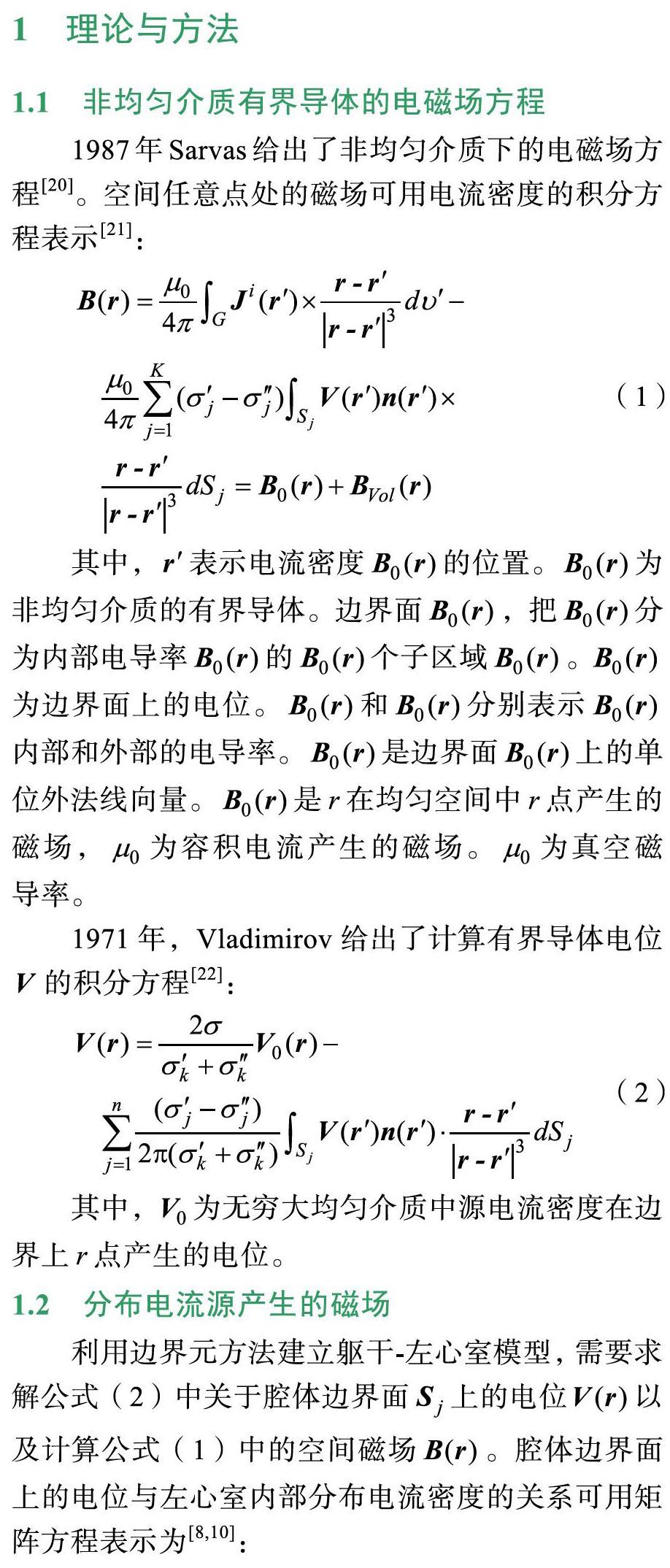动态躯干—左心室模型的初步研究
2019-10-08陈凯文朱俊杰姚晓松
陈凯文 朱俊杰 姚晓松



摘 要: 为研究心室变化对心脏磁场的影响,本文利用健康人彩色多普勒成像提取一个心动周期的左心室图像数据,建立了一个动态的磁场边界元模型。文中基于该模型研究了电流偶极子在左心室舒张期220 ms和320 ms时刻所产生的心脏磁场数据,结果显示当偶极子位于左心室腔内时,220 ms时刻的磁场强度大于320 ms时刻的磁场强度;当偶极子位于左心室腔外(心肌中)时,磁场强度相对前者的变化小,且320 ms时刻的磁场强度略小于220 ms时刻的磁场强度。此外文中仿真了健康人的整个心动周期的心脏磁场,并与实测的心脏磁场数据进行了对比,仿真结果显示仿真的心脏磁场的强度整体上小于实测磁场。这说明了利用彩色多普勒成像数据分别对左心室舒张初期和舒张末期的心脏磁场进行建模仿真能获得更多的特征信息。
关键词: 心磁图;边界元法;左心室;彩色多普勒成像
中图分类号: TN911.73 文献标识码: A DOI:10.3969/j.issn.1003-6970.2019.06.008
本文著录格式:陈凯文,朱俊杰,姚晓松,等. 动态躯干—左心室模型的初步研究[J]. 软件,2019,40(6):3439
【Abstract】: In order to study the influence of ventricular changes on the heart magnetic field, this paper established a dynamic magnetic field boundary element model using a healthy human color Doppler imaging to extract the left ventricular image data of a cardiac cycle. In this paper, we studied the cardiac magnetic field data generated by the current dipole at left 220 ms and 320 ms based this model. The results showed that the dipole in the left ventricle the intensity of the magnetic field at 220 ms is greater than intensity of the magnetic field at 320 ms; when the dipole out the left ventricle (in the myocardium) the intensity of the magnetic field is smaller than the former, and the intensity of the magnetic field at 320 ms is slightly smaller than intensity of the magnetic field at 220 ms. In addition, we simulated a whole heart cycle of the healthy peoples heart magnetic field and compared with the SQUID magnetic field data. The simulation results show that the intensity of the simulated cardiac magnetic field is less than the SQUID magnetic field. It indicates that more characteristic information can be obtained by modeling and simulating the cardiac magnetic field at the left ventricular initial-diastolic and end-diastolic respectively by using color Doppler four-dimensional imaging data.
【Key words】: Magnetocardiography; Boundary element model; Left ventricular; Color Doppler ultrasonography
0 引言
進入21世纪后,多通道超导量子干涉仪(super?conducting quantum interference device,SQUID)在心脏磁场中的应用为心脏磁场的研究带来了新的发展机遇。超导量子干涉仪能够在人体表面测量出心脏磁场信号并用心磁图(magnetocar-diography,MCG)表示出来[1-2]。在心脏磁场的正问题和逆问题研究中,通常会建立一个包含人体心脏和躯干的模型用于研究心脏磁场的研究。由于心脏组织结构的较为复杂跳动时伴随着扭转,因此,建立一个符合人体解剖学原理和心脏电生理学的人体心脏模型对心脏磁场的研究是非常有必要的。
在心脏磁场的研究中通常使用医学成像来建立人体的心脏、躯干等模型。1991年J Nenonent和Forsman K等建立了包括心脏和肺部在内的真实的躯干模型并以此模型研究了不同条件下和器官和血液对心磁图的影响[3]。近年来,浙江大学的夏灵等人利用CT图像用有限元法建立了心脏-躯干模型,基于该模型进行心电仿真[4,5],张琛和寿国法等人利用CT图像建立了包含肺部和心脏的人体躯干边界元模型,其中心脏模型只有半个心脏包含两个心室,利用该模型研究了仿真的MCG和实测数据的差异[6,7]。Czapski P和Ramon C等人曾利用核磁共振成像(magnetic resonance imaging, MRI),建立了包含心脏在内的人体躯干模型[8, 9],文中指出,MRI对软组织的对比度明显高于CT。同济大学的蒋式勤等人根据胸腔MRI图像数据建立了一个包含心房、心室的多腔体心脏—躯干BEM模型,并将其用于完全性左、右束支传导阻滞(complete right bundle branch block/complete left bundle branch block, CLBBB/ CRBBB)病人的电兴奋传导研究[10-12]。此外Soo-Kng Te和Sarayu Parimal等人利用MRI成像建立了一个有限元的心脏模型,该模型用于研究心脏运动过程中心壁的形变[13]。2016年Erick A Perez Alday和Chen Zhang等建立了躯干和心脏模型,通过该模型研究了ECG和MCG的差异[14]。
4 结论
本文采用彩色多普勒4D成像技术提取到清晰度更高的完整心动周期的心脏解剖结构数据,并根据舒张过程中的左心室边界,分别研究了220 ms和320 ms时刻的躯干—左心室磁场边界元模型。研究结果表明,当偶极子的偶极矩固定,给定的单电流偶极子位于左心室内部时,这两个时刻的磁场图在大小、空间分布有较为明显的差异;当偶极子位于左心室腔外时,这两个时刻的模型所产生的磁场数据整体上都大于偶极子位于左心室腔内时的磁场数据,而这两个时刻的磁场分布和大小的变化并不明显;这种差异主要是心室边界变化所导致的。这就说明在心脏磁场建模过程中非常有必要考虑心脏收缩过程对心脏磁场所造成的影响。这也说明对于心脏舒张时期,在心脏正问题和逆问题研究中都应进行相应的分析处理,从而使得结果与心脏电生理过程更加吻合。此外,本文对一个心动周期内健康人的心脏磁场进行了仿真,实验结果表明,仿真的磁场的强度小于SQUID实测心脏磁场,QRS群波时段明显小于实测心脏磁场值。
综上所述,利用彩色多普勒4D成像对于建立更为精确的心室模型是必要的。针对心脏舒张期内心脏的不同形态构建心脏磁场模型,从而对心磁模型进行深入的研究,这将有助于对心脏磁场的产生、传播等机理有一个更为全面的认识。
参考文献
[1] Cohen D, Hosaka H, Magnetic Field Produced by a C urrent Dipole [J]. Journal of Electrocardiology, 1976, 9(4): 409- 417.
[2] De Melis M, Tanaka K, Uchikawa Y. Magnetocardiography Signal Reconstruction with Reduced Source Space Based on Current Source Variance [J]. IEEE Transactions on Magnetics, 2010, 46(5): 1203-2107.
[3] Nenonen J, Forsman K, et al. Magnetocardiographic localisation and modelling[J]. Institute of Physical Sciences in Medicine. 1991. 12: 11-14.
[4] Xia Ling, Huo Meimei, Wei Qing, et. al. Analysis of cardiac ventricular wall motion based on a three-dimensional electromechanical biventricular model [J]. Physics in Medicine and Biology, 2005, 8(50): 1901-1917.
[5] Shou Guofa. Xia Ling, Jiang Mingfeng, et. al. Solving the ECG Forward Problem by Means of Standard h- and h-Hierarchical Adaptive Linear Boundary Element Method: Comparison With Two Refinement Schemes [J]. IEEE Transactions on Biomedical Engineering. 2009, 5(56): 1454-1464.
[6] Shou Guofa, Xia Ling, Ma Ping, et al. Simulation study of a magnetocardiogram based on a virtual heart model: effect of a cardiac equivalent source and a volume conductor [J]. Chin. Phys. B, 2011, 20(3): 030702.
[7] Zhang Chen, Shou Guofa, Lu Hong, et al. A new magneto- cardiogram study using a vector model with a virtual heart and the boundary element method [J]. Chin. Phys. B, 2013, 22(9): 090701.
[8] Czapski P, Ramon C, Haueisen J, et al. MCG Simulations of Myocardial Infarctions with a Realistic Heart-Torso Model [J]. IEEE Transactions on Magnetics, 1998, 45(11): 1313- 1322.
[9] Ramon C, Czapski P, Haueisen J, et al. MCG Simulations with a Realistic Heart-Torso Model [J]. IEEE Transactions on Biomedical Engineering, 1998, 45(11): 1323-1331.
[10] 王偉远, 赵晨, 林玉章, 张树林, 谢晓明, 蒋式勤. 心脏磁场分布电流源重构及其精度分析 [J]. 物理学报 2013, 62(14): 148703.
[11] 朱俊杰, 蒋式勤, 王伟远, 等. 多腔体心脏磁场模型的研究与应用 [J]. 物理学报 2014, 63(5): 058703.
[12] 周大方, 張树林, 蒋式勤. 用于心脏电活动成像的空间滤波器输出噪声抑制方法[J]. 物理学报2018, 67(15): 158702.
[13] Soo-Kng Te, Sarayu Parimal, Like Gobeawan, et. al. Reconstruction of 3D Dense Cardiac Motion Field from Cine and Tagged Magnetic Resonance Images [J]. Computing in Cardiology, 2016, 43: 1-4
[14] Erick A Perez Alday, Haibo Ni, Chen Zhang. Michael A. Colman, Zizhao Gan, Henggui Zhang. Comparison of Electric-and Magnetic-Cardiograms Produced by Myocardial Ischemia in Models of the Human Ventricle and Torso [J]. PLOS ONE, 2016 8. 11: e0160999.
[15] Dekker D L, Piziali R L, Jr E D. A System for Ultrasonically Imaging the Human Heart in Three Dimensions [J]. Comput Biomed Res, 1974, 7: 544-553.
[16] Martin R W, Bashein G, Zimmer R. An Endoscopic Micromanipulator for Multiplanar Transesophageal Imaging [J]. Ultrasound in Med. & Biol, 1986, 12: 965-975.
[17] Van Ramm O T, Smith S W. Real Time Volumetric Ultrasound lmaging System [J]. Journal of Digital Imaging, 1990, 3: 261-266.
[18] Li Zhian, Wang Xinfang, Lu Ping, et al. Study on three- dimensional reconstruction of transesophageal echocardiographic images [J]. Journal of Tongji Medical University, 1995, 15: 10-15.
[19] Wang XF. Four-dimensional echocardiography: imaging methods and clinical applications. J Clin Cardiol, 1995, 11: 383–384.
[20] Sarvas J. Basic mathematical and electromagnetic concepts of the biomagnetic inverse problem [J]. Phys. Med. Biol. 1987, 32: 11-22.
[21] Geselowitz D B. On the Magnetic Field Generated Outside an Inhomogeneous Volume Conductor by Internal Current Sources [J]. IEEE Transactions on Magnetics, 1970, 6(2): 346-347.
[22] Vladimirov V S. Equations of Mathematical Physics (New York: Marcel Dekker) [M]//Boundary Value Problems for Elliptic Equations: Discontinuity of the Potential of a Double Layer. 1971: 302-304.
[23] Stenroos M, M?ntynen V, Nenonen J. A Matlab library for solving quasi-static volume conduction problems using the boundary element method [J]. Computer Methods and Programs in Biomedicine, 2007, 88(3): 256-263.
[24] Gabriel S, Lau R W, Gabriel C. The dielectric properties of biological tissues: III. Parametric models for the dielectric spectrum of tissues [J]. Phys. Med. Biol. 1996, 41: 2271- 2293.
[25] Rush S, Abildskov J A, Mcfee R. Resistivity of Body Tissues at Low Frequencies [J]. Circulation Research, 1963, 12: 40-50.
[26] Keller D U J, Weber F M, Seemann G, et al. Ranking the influence of tissue conductivities on forward-calculated ECGs [J]. IEEE Transactions on Biomedical Engineering, 2010, 57: 1568-1576.
